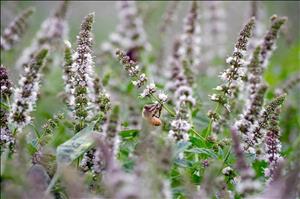In spring of 1946, the I. P. Callison Company ships two train cars of Scotch spearmint root from Indiana to the Yakima Valley and plants them on leased farmland near Sunnyside. The plantings are designed to determine whether or not the Yakima Valley is a favorable location to grow spearmint for its oil on a commercial scale. The plantings mark the first time spearmint has been grown commercially in the state. In time, the Yakima Valley becomes the most-productive spearmint-oil-producing region in the history of the commercial mint industry.
Mint from the Northwest
Founded in 1903 by former teacher and newspaper publisher Israel Putnam Callison (1870-1961), the Callison Company marketed pharmaceuticals and wild plants. In 1941, Callison purchased W. J. Lake and Company, a small firm that dealt in peppermint oil -- at the time, the only mint oil produced commercially in Washington -- among other products. By 1943, Callison was focused on expanding this peppermint-oil trade. The firm undertook a national advertising campaign to promote sales of western-grown mint, using the slogan "The finest peppermint comes from the Pacific Northwest."
The company also decided to test the possibility of commercial spearmint production in Washington, and in the spring of 1946 arranged for the shipment of two train cars of Scotch spearmint root from Indiana to the Yakima Valley. The roots in one of the train cars were damaged in transit and could not be planted. Callison brought in additional root stock from Coberg, Oregon. This initial planting amounted in total to 160 acres, and produced its first harvest in 1947. Seeing that the Yakima Valley's long sunny days and irrigated fields produced a healthy crop, nearby growers obtained roots and followed suit.
Callison's plantings were of Scotch spearmint (Mentha spicata). Spearmint was grown in Europe from about the ninth century B.C. At the time Callison planted spearmint in Washington, most of the country's mint oil was produced in Michigan and Indiana.
During the late 1940s, surpluses of Midwest-grown spearmint lowered spearmint oil prices, discouraging the Yakima Valley's fledgling spearmint industry. By 1951, spearmint plantings in the Yakima area amounted to no more than 50 acres.
In 1952, Henry Callison (1898-1994), I. P. Callison's son and formerly the company's general manager, struck out on his own, taking over Broadview Farms, an existing operation north of Sunnyside. Spearmint prices had rebounded somewhat and he bought up roots from other farmers, expanding his acreage.
By 1955, Washington had become the nation's leading spearmint-oil producer. That year, Henry Callison's Broadview Farms planted spearmint in the Columbia Basin near Othello. Othello eventually became the state's second-highest-yielding spearmint region, after the Yakima Valley.
Henry Callison introduced native spearmint (Mentha cardiac) to the Yakima area in 1957, using roots grown in Indiana. By 1967, 6,000 acres of the Yakima Valley's 15,000 acres of spearmint were planted with native spearmint. Native spearmint is resistant to Verticillium wilt, a fungal disease that plagues peppermint and, to a lesser extent, Scotch spearmint.
As of 2017, Washington produced 2,100,000 pounds of spearmint oil, more than any other state.

